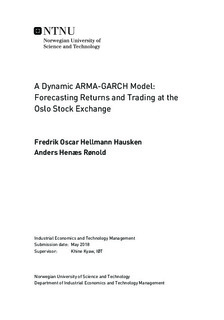A Dynamic ARMA-GARCH Model: Forecasting Returns and Trading at the Oslo Stock Exchange
Master thesis
Permanent lenke
http://hdl.handle.net/11250/2573100Utgivelsesdato
2018Metadata
Vis full innførselSamlinger
Sammendrag
This study aims to contribute to the existing literature in three ways. Firstly, we try to highlight the dynamic forecasting model behaviour, by investigating the values of the forecasting model's input parameters - the GARCH model, AR-lag, MA-lag and the underlying return distribution - over time. Secondly, we seek to describe the dynamic forecasting model in detail and then evaluate it in terms of both statistical and return generating properties, without transaction costs. Thirdly, we describe how the dynamic forecasting model can be used for trading purposes in real-life scenarios, by considering two trading strategies and transaction costs.
Our results assert the dominance of E-GARCH-M, the GJR-GARCH-M to be a good fit, the tendency of constant ARMA($4,4$), and a generalised error distribution (GED) to be the best fit for stocks. This is reflected with both sample sizes.
Further, we show that a dynamic ARMA-GARCH forecasting model can work. In a scenario without transaction costs, using a short-long strategy, with the sample size set to 1000, the forecasting model performance is impressive, obtaining an annualised alpha of 3.51\%. When introducing transaction costs, with the same sample size, we observe that the cost of trading destroys returns, generating an annualised alpha of -17.48\%.
We then introduce the bound strategy, to reduce the number of trades, only trading when the forecasting model forecasts returns above or below the trading bound. The bound strategy, with sample size 1000 and the trading bound set to 35\% of the current GARCH volatility forecast, outperforms the short-long strategy, but falls short of the buy-and-hold strategy, with an annualised alpha of -0.18\%. The transaction costs are too return destroying.
Lastly, the return forecasting performance of high-volatility stocks is good. Collectively, a dynamic ARMA-GARCH, with sample size 1000, the bound strategy and forecasting high-volatility stocks, can be successful.
